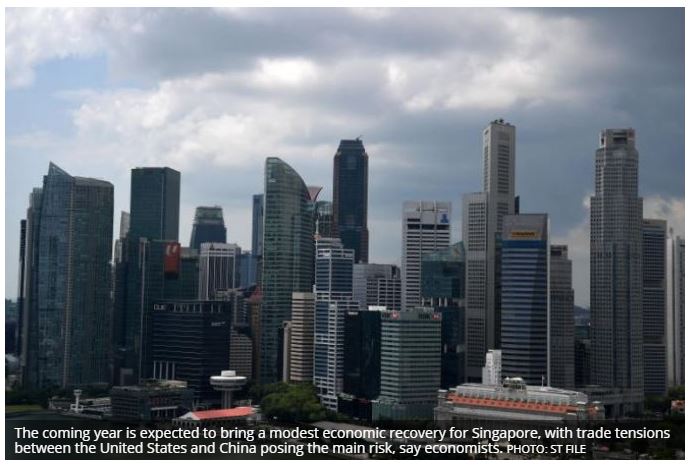Modest economic recovery expected for Singapore in 2020
THE coming year is expected to bring a modest economic recovery for Singapore, with trade tensions between the United States and China posing the main risk, say economists.
Manufacturing woes in 2019 were due to trade tensions, high base effects from 2018, and a slowdown in the global electronics cycle. The latter two, at least, will not apply in 2020.
DBS analyst Ling Lee Keng notes that the global semiconductor market is expected to return to growth next year, with big players giving positive outlook guidance.
Maybank Kim Eng economists Chua Hak Bin and Lee Ju Ye similarly see manufacturing and export figures improving “as the uncertainty from the tariff shock dissipates”.
With this, they see “a broadening growth recovery, albeit sluggish, in 2020”, with gross domestic product growth of 1.8 per cent, up from their forecast of 0.9 per cent in 2019.
Granted, this is under their base-case scenario that the US and China reach a partial trade deal before the US presidential elections in November 2020.
Trade relations remain “the big risk”, with failure to reach a partial deal – and another round of tariff hikes – set to “derail any hopes of an export recovery”.
While also expecting a manufacturing-led marginal improvement next year, HSBC chief Asean economist Joseph Incalcaterra sees the semiconductor movements as “more a short-term stabilisation rather than the start of a new cycle”.
He also expects manufacturing stabilisation to be due to improved biomedical and precision engineering output instead.
OCBC Bank chief economist Selena Ling forecasts growth of one to 2 per cent in 2020, noting familiar headwinds of US-China trade worries, as well as Federal Reserve and Brexit uncertainties, adding: “In summary, it is still too early to break out the champagne.”
In the latest Monetary Authority of Singapore (MAS) quarterly survey of professional forecasters, the median forecast was for 1.5 per cent growth in 2020, with the most probable growth range being 1.5 to 1.9 per cent.
This is within the higher half of the Ministry of Trade and Industry’s forecast range of 0.5 to 2.5 per cent.
Apart from manufacturing and trade, tourism is another sector seen as being “on the road to recovery”, according to DBS chief economist Taimur Baig and economist Samuel Tse.
The Maybank economists see services growth strengthening on financial, business and tourism-related activities.
The ongoing unrest in Hong Kong may cause Mice (meetings, incentives, conferences and exhibitions) events and some multinational corporations’ functions to be diverted here.
But one possible stumbling block is the upcoming tightening of foreign labour quotas in services, they added, noting that “some labour-intensive sectors are already struggling”.
Business cessations in food and beverage and retail trade have surged by more than 30 per cent since the second quarter, echoing the downsizing seen after the last tightening in July 2015.
Construction will also continue growing, supported by the expansion of the integrated resorts, redevelopment of en-bloc residential sites, and major infrastructure projects such as Changi Terminal 5 and the Tuas Mega Port, said the Maybank economists.
Contracts awarded have risen to a four-year high, with a pick-up in both the public and private sectors.
Expectations of recovery notwithstanding, Ms Ling raises the possibility of further labour market softening, with the third quarter’s overall unemployment rate of 2.3 per cent representing a decade-long high.
Indeed, Mr Incalcaterra expects private consumption to soften due to “some gradual deterioration in the labour market”.
However, noting that hiring has picked up in all three key sectors of manufacturing, services, and construction, UOB economist Barnabas Gan’s view is that the slowdown in headline growth has not translated into labour-market weakness. On the contrary, the story is one of labour-market resilience, he added.
Firms are opting to put workers on shorter work weeks or temporary lay-off arrangements rather than retrenching, suggesting expectations of recovery soon, he said.
Latest figures show that retrenchments in the 12 months till September 2019 were lower than in the preceding two 12-month periods.
Unsurprisingly, the escalation of trade tensions remains the main downside risk to growth, cited by nearly nine in 10 respondents to the MAS survey.
Nonetheless, even if recovery is derailed by external developments, the government has said it stands ready to provide support.
As Asean+3 Macroeconomic Research Office director Toshinori Doi put it: “Policymakers have ample policy space and are well-prepared to support the economy.”
DBS economists see a “robust fiscal budget” as more likely than a short-term stimulus package, particularly as the next general election – due by 2021 – is expected to be held soon.
But BofA Securities Asean economist Faiz Nagutha sees monetary policy action as more likely than fiscal stimulus, motivated by concerns over inflation more than growth.
Contrary to current expectations for the MAS to hold steady in April, he expects a move to a neutral slope instead.
Heading into the April decision, core inflation is likely to stay below one per cent, he said, noting disinflationary pressures from healthcare subsidies that kicked in last month and preschool subsidies in January.
In the MAS survey, the median forecasts for 2020 were 1.2 per cent for core inflation and 0.9 per cent for headline inflation.
Source: https://www.businesstimes.com.sg/government-economy/modest-economic-recovery-expected-for-singapore-in-2020


 English
English




